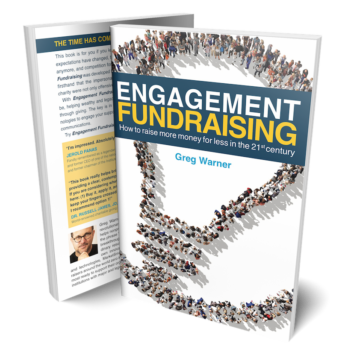We use cookies to ensure that we give you the best experience on our website. By continuing to use this site, you agree to our use of cookies in accordance with our Privacy Policy.
 Login
Login
Your Role
Challenges You Face
results
Learn
Resources
Company
The 7-Step Donor Journey from Stranger to Philanthropic Partner


All your donors are on a journey, whether they know it or not. Some of them are on a journey to get as far away from your organization as they can get. But most of them are looking for someone to go with them on their journey. And if you make yourself available in a friendly, relatable, curious, and sincere way, they’ll welcome your company.
For major donors, this is even more important, because few people who give away large sums of money want to do it in total obscurity. Yes, some donors wish to be anonymous. But that’s typically only from the eyes of other donors. To make their gifts anonymous, they need your help to navigate the process and fulfill their lifelong desires and philanthropic goals.
To help your wealthier donors embark and progress along their donor journey requires seven steps.
And these are more like challenges than steps. They are levels. You as the guiding sage take the lead along the perilous path. You step through the thicket. You ascend the boulders. Then, you reach out your hand and lead the donor up and forward – where they want to go.
Each time, the donor has to make a decision:
Do I really want to keep going this way? Do I really want this person’s help? Am I ready for this?
Some will shrink back, and you’ll have to wait for them. Others will take your challenge and keep moving forward.
7 Steps in the Major Donor Journey
Let’s look at each of these steps, in the order they must happen if you want to realize the biggest gifts from the happiest donors.
Step 1: You Ask for Their Input
The journey begins when you offer them an opportunity to share their thoughts or other information. This works best as a survey, poll, quiz, or some other form the supporter gets to fill in. And at this point, they probably aren’t yet a donor. They may have given some small gifts in the past. They may even be a monthly donor, giving a relatively small amount.
But this is the journey to becoming a major donor, and it starts with a survey.
When the supporter fills this out, they are agreeing to engage with you on a deeper level. They have taken an offer you initiated and that they responded to. Now, you’re connected, even at arm’s length.
It’s all at their convenience. They haven’t committed to much yet. But they have entered through a door you opened for them. This is the first step, the first challenge.
Step 2: You Invite Them to Opt in for Further Communication
This step works best as part of the survey from the first step.
Ask them directly if they want to continue and to enhance their connection with your organization. You could be offering something as simple as regular monthly updates. Better is some form of more personal cultivation. It could come from you or others in your organization. But it will still be at arm’s length.
The main point here is – this person is now giving permission to continue this relationship and hear more about your mission and your cause.
Some will not be willing to take this step. And that’s okay. You might be looking at a wealth screening report with a supporter’s name on it and think they’re a great candidate to be a major donor. But if they refuse your offer to simply receive some low-level communication, then no – they aren’t a good major donor prospect. Not yet anyway.
This is a major flaw with wealth screeners. They may report giving history and net worth – assuming it’s accurate – but they can’t determine a supporter’s willingness to actually engage with your organization.
Step 3: You Offer the Opportunity for Personal, Ongoing Follow-Up from You
As part of what you send them when they opt in to hear from your organization, eventually, you will offer them the chance to hear from you more directly.
This can also be done through a follow-up survey – not the same one from step 1 – but it will be a much more meaningful and substantive survey that asks them more engaging and personal questions, such as, “Who influenced you to become a person who gives to charity?”
As part of that survey, you’ll be getting permission to initiate a more personal form of follow-up. They’ll know the name of someone at your organization. They’ll be hearing from you, not just a random newsletter. The ‘you’ could be a gift officer. It could be someone we called a Lead Outreach Associate, who warms supporters up before they meet a gift officer.
The point is, now the supporter knows someone at the organization.
This stage may take quite a long time to progress through. It might take years. They’ll signal how much they want to hear. They’ll engage more at various points and less at others. But what you’re doing here is building and deepening a relationship. You’re getting to know them on a much deeper level.
What motivates them to give? What are their values? What moves them emotionally? What inspires them? What angers them? What do they want to see change in the world?
In this part of the major donor journey, you’ll be uncovering these sorts of things – for you and for the donor. Before interacting with you in this stage, they may not have realized they felt or believed these things. But as you draw it out of them, they’ll realize what matters to them as it relates to your cause.
When the time is right, you’ll offer them the fourth challenge.
Step 4: You Invite Them to Meet One on One
This is a big one, because meeting in person is a clear indication that this relationship has reached a higher level. If there was any doubt before, it’s gone now.
The supporter is now taking a much bigger risk. They might be excited. A little nervous. A bit intrigued. Will this person just ask me for money? Or will we keep talking about the things we’ve been talking about over email and other channels?
When the supporter says yes to this offer, you’re not going to blow this moment by asking for a big gift in your first meeting. That’s not why the supporter is meeting with you this first time. They’re looking for more of what you’ve been giving them over email, but now as a real conversation.
If they decline to meet in person, you can continue in stage 3, and revisit this challenge after more cultivation has transpired.
Step 5: You Invite Them to Join Your Caseload
At your first meeting, you don’t ask for money. But you will ask them to partner with you as you develop what we call a roadmap. This is a strategic giving plan that you promise to develop.
It doesn’t commit them to making any gifts. But it allows you to take what you’ve learned about this person and begin creating a plan that will enable them to fulfill their philanthropic goals, and experience the joy and fulfillment they seek through giving. It will connect their values, life experiences, and other giving motivators to your programs and initiatives – the ones they will care about most.
The roadmap seeks to achieve four goals for the supporter:
- Reflect on why they care
- Understand where needs exist
- Consider a menu of options
- Recognize the value they could gain
You’ll craft this plan on an individual basis. No two plans will look the same. Supporters who agree to this are curious about what you’ll come up with. They’re invested in their relationship with your organization. They want to see what you’ll bring them.
If they decline this option, you can continue with level 3 communications, and seek to meet again in person at a future date to sustain the relationship at the level you’ve already reached.
Step 6: You Invite Them to Collaborate on a Giving Proposal
When you meet again to discuss the roadmap you created, you’re looking to see how the supporter reacts to it. If they love what you’ve developed, then this person is ready to prepare to make their major gift.
The sixth challenge is to ask them to partner with you as you create a giving proposal. It will incorporate the components of the roadmap that most resonated with them. The giving proposal will lay out what they can give, where it will go, where it will come from, and various other details specific to their life and financial situation.
If they react with less enthusiasm to your roadmap, you can just keep discussing it and figure out which parts aren’t aligning with where their passions and interests lie. What worked? What didn’t? Then you can rework it and come back again.
Either way, you’ve come this far, so you want to make sure you’re in agreement here so the giving proposal you work on will be a smooth process with no surprises.
Step 7: You Encourage Them to Share Their Wealth and Fulfill Their Dreams
Finally, you bring the giving proposal to them and offer the opportunity to breathe life into it by making their gift.
This is the moment when they gain a great personal victory, experience the joy of a newly enhanced identity, and realize that their life will never be the same. This moment marks their life and now defines their existence in a way that nothing before it did.
And that’s the end of the donor journey. They have gone from tentative, distant, and unsure, but curious, to fulfilled, thrilled, delighted, and emotionally resonant with your mission and cause.
This journey can take years. And that’s okay. For some, it might be faster. But as long as you remain faithful to the process, you’ll end up with more major donors who will be very happy to partner with you and advance your mission.
And of course, this may actually not be the end of the donor journey. You can continue stewarding this relationship and possibly win more big gifts or perhaps legacy gifts later on. But all of that depends on progressing through these seven stages.
Surveys – Your First Step
As you went through the seven stages of the major donor journey, you may have noticed the pivotal role played by supporter surveys. These are how you initiate the process and advance it at key moments.
To learn more about this, see 6 reasons why donor surveys work at engaging wealthy donors and prospects.
Related Resources:
- Don’t Just “Find” Donors; Build Relationships for Lasting Impact
- Why You Don’t Want Short-Term Results — 4 Reasons (Plus 6 Reasons Why You Want Long-Term Relationships Instead)
- Revolutionize Fundraising: Let’s Stop Making it Uncomfortable
- 4 Primal Motives for Major Gifts – the REAL Reasons People Make Transformational Gifts
LIKE THIS BLOG POST? SHARE IT AND/OR LEAVE YOUR COMMENTS BELOW!
Get smarter with the SmartIdeas blog
Subscribe to our blog today and get actionable fundraising ideas delivered straight to your inbox!
